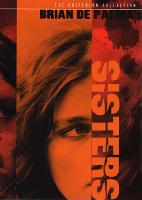![[Deep Focus]](../../../flicker/dvd/logo.gif) |
|||
|
SISTERS |
|
Directed by Brian De Palma Written by De Palma and Louisa Rose from an original story by De Palma Cinematography by Gregory Sandor Edited by Paul Hirsch Starring Margot Kidder and Jennifer Salt USA, 1973
| |
|
DePalma's highly advanced narrative style is not as tyrannical as that of Cronenberg or Lynch, who regularly make you feel like your brain chemistry is being altered by the mere act of watching. But his strategy is deployed here with a precision that he occasionally matched, but never exceeded, later in his career. The split screen, which would become a trademark DePalma effect, is a jazzy variation on film grammar, directing the eye and commenting on the action in ways that make Mike Figgis look hopelessly clumsy. (Nobody since has used split-screen as well, save for Darren Aronofsky, whose Requiem for a Dream is on the money.) The staging of violence is both shocking and ridiculous, with bloodletting and flesh-tearing that recall the controlled environment of a Hammer horror film and the boundless capacity for grossness of Herschell Gordon Lewis. And the aforementioned dream sequence seems informed largely by Tod Browning's Freaks; in turn, it probably helped make Eraserhead possible. You can feel the director straining against his own limitations here. Unlike Hitchcock, he couldn't afford to hire the best actors of the day, and wound up settling for unknowns. The resulting performances are unconvincing. DePalma felt that hiring Bernard Herrmann to score the film was a major coup, but the music too often feels like homage to itself. Finally, DePalma's instincts were hampered by budgetary restrictions. In one of the interviews included in the Criterion Collection's DVD package, he laments the loss of an elaborate back-and-forth tracking shot that would reveal a crucial bit of information about a crime scene; re-shoots, of course, were out of the question.
Criterion's new DVD offers a new, clean transfer from the original 35mm negative. I've seen some complaints online about the amount of grain in the image, or the slightly washed-out look of some scenes, but let 'em cavil -- this looks exactly like a low-budget American film from the early 1970s should look, and Criterion has done a masterful job in making the DVD version retain the texture of the original film stock without exhibiting the digital blockiness and instability that have plagued other DVDs struck from difficult source material. Colors are rich and true, and the film is presented for the first time in a widescreen transfer that preserves the original shot compositions and split-screen framing (there are tiny black bars on either side of the anamorphic image, making the aspect ratio figure to just under 1.77:1). The sound is clean, clear monaural.
Supplementary material is informative but hardly overwhelming. (Can't somebody sit this man down for a commentary?) In all, I spent about a half-hour with it. The fold-out booklet includes an amusing article the director wrote for the Village Voice about working with Herrman as well as a perceptive essay by film scholar Bruce Kawin. The disc itself contains the text of Dawn of the Dead producer Richard Rubinstein's 1973 interview with De Palma and the original Life magazine article on a pair of Russian twins that originally got De Palma's wheels a'turning. Also included are scores of promotional materials, including ad flats and production stills. You could argue that these stills should have been cherry-picked to reduce redundancies, but there's an intangible benefit to offering so many photographs -- I loved the feeling of pawing through an archive of film negatives, as though I were making each discovery for myself. Not an especially meaty package, as it turns out, but an altogether satisfying one.
| |||
| |||

| |||

 http://www.deep-focus.com/flicker/
bryant@deep-focus.com
http://www.deep-focus.com/flicker/
bryant@deep-focus.com